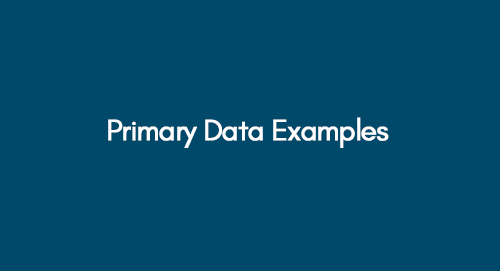
Humanities Research Topics | 135 Trending Ideas in 2025
November 17, 2022
How to Write a Reflection Paper: Guidelines with Examples
November 22, 2022Dissertations are the culmination of years of academic dedication and research. You often need to incorporate primary data to create a dissertation that stands out and adds value to your field of study. This article will explore the significance of primary data in your dissertation and provide practical examples to help you get started.
Learn an Expert Way to Analyse Data Here
Primary data is the firsthand information that researchers collect directly from the source, untainted by interpretation or manipulation. Whether you're conducting an in-depth market study, unravelling the mysteries of a scientific phenomenon, or seeking to understand societal trends, the acquisition and utilization of primary data are pivotal. Learn from practical primary data examples in our blog post, and harness the potential of firsthand information for your research needs.
Understanding the Importance of Primary Data
Primary data refers to data that you collect firsthand for your research. This can include surveys, interviews, experiments, observations, or any other data that you generate specifically for your dissertation. While secondary data (data collected by others) can be valuable, primary data offers several advantages:
Relevance: Primary data is tailored to your research question, ensuring it directly addresses your dissertation's objectives.
Freshness: You have control over the data collection process, allowing you to ensure it is up-to-date and aligned with current trends and developments in your field.
Uniqueness: Collecting your own data sets your work apart from others and adds originality to your dissertation.
Ownership: You have full ownership of the data, which means you can analyze it from various angles and adapt it to your research needs.
Examples of Primary Data
Presented below are the primary data examples featured in the dissertation.
- Example 1: Impact of Leadership Style on the Job Satisfaction of Nurses
- Example 2: Effect of Brand Love on Consumer Buying Behaviour in the Dietary
- Example 3: An Insight into Alternative Dispute Resolution
Completing a dissertation is necessary for many students seeking to earn their Ph.D. A dissertation is an extensive research project that allows students to conduct original research and present their findings on a particular topic. Because of its significance, it is important to ensure that your dissertation is well-researched and written.
One way to improve the quality of your dissertation is to use primary data. Primary data is data that you collect yourself through surveys, interviews, or observations. In contrast, someone else already collects secondary data, such as data from a government website or an article in a scholarly journal.
What is Primary Data? Why Should You Use It in Your Dissertation?
Primary data refers to information that a researcher collects firsthand. In simpler terms, it's data you gather yourself through methods like surveys or interviews. It's crucial to understand that primary data isn't found in books or articles; it's something you have to gather on your own.
Primary data offers deep and detailed insights you can't find in secondary sources, making it vital for dissertation researchers. Yet, it's smart to use primary data thoughtfully and think about other ways to collect data if primary data isn't the best choice.
Explore these primary data examples to understand where you can find your materials.
Organizational Market Research
A business must do market research before launching a product or expanding into new geographic areas. It can take many different shapes; however, it almost always entails collecting primary data.
For instance, they may conduct a survey of current clients to learn more about their product preferences before selecting a group for more in-depth interviews. They may then aim their marketing or product development efforts appropriately.
Essays and Reviews
A magazine review of one of Thomas Auer's books is a secondary source if your essay is about her books. However, the review is the main source if your thesis is about how critics have received Thomas Auer's writing.
How Can You Collect Primary Data for Your Dissertation Project?
1. Questionnaires
One way to collect primary data for your dissertation project is to administer questionnaires to a group of people. A questionnaire is a set of questions given to respondents to collect data about a particular topic. When creating a questionnaire, it is important to ensure the questions are clear, concise, and relevant to the research topic.
2. Interviews
Another way to collect primary data for your dissertation project is to interview experts on the topic. An interview is a conversation between two or more people exchanging information. When conducting an interview, it is important to ask open-ended questions that will allow the respondent to provide detailed answers.
3. Survey
One of the most common methods for analyzing primary data is through surveys. Surveys can be administered in various ways, including in person, by phone, or online. Surveys are typically used to collect data on a large number of people and can be used to collect data on various topics.
4. Focus Groups
A focus group is a type of interview conducted with a group rather than just one individual. Focus groups typically gather data about people's opinions on a particular topic. When conducting a focus group, it is important to have a moderator who can keep the discussion on track and ensure that all participants have a chance to share their thoughts.
5. Observations
Another way to collect primary data for your dissertation project is through observations. This involves observing people's behaviour in natural settings without interfering with it. Taking detailed notes and recording observed behaviours is important when conducting observations.
6. Experiments
Experiments are another way to collect primary data for your dissertation project. It involves manipulating one or more variables and observing the effect on another variable. Experiments must be carefully designed to be ethical and produce valid results.
7. Secondary Data Analysis
Another approach for obtaining primary data in your dissertation project is through secondary data analysis. This method entails examining pre-existing data sets gathered by other researchers. When conducting secondary data analysis, it's vital to select a dataset pertinent to your research subject and obtained through dependable methods.
How to Structure Your Data in a Dissertation
There are two types of data which you will use whilst writing your dissertation – primary and secondary.
- Primary data is data that you have collected yourself.
- Secondary data is data that others have already collected.
Your primary data should always come first in your dissertation, followed by your secondary data. However, there are a few exceptions to this rule. For instance, if you are writing a historical dissertation, it may be more appropriate to structure your data chronologically.
When it comes to structuring your primary data, there are three main ways in which you can do so:
Based on Themes
This means grouping together participants or items of data that share common themes. For example, if you were conducting a study on the different reasons why people choose to vote, you could group participants who chose to vote for the same party or those who cited the same reason for voting.
Based on Participant Characteristics
This means grouping together participants or items of data that share similar characteristics. For example, if you were conducting a study on the different reasons why people choose to vote, you could group participants who are of the same age, gender or nationality.
Using a Case Study Approach
This means investigating a single case in depth whilst also providing information on other cases that may be similar or contrasting. For example, suppose you were conducting a study on the different reasons why people choose to vote. You could use a case study approach to investigate one particular political party in depth.
How Can You Use Primary Data to Support Your Arguments and Conclusions?
When you're trying to prove something or finish your discussion, it's really important to show proof of what you're saying. Primary data is a kind of proof that you collect yourself, not something you find in a book or online. Primary data can look different depending on what you're studying and what information you want to collect.
For example, you might collect primary data by interviewing, surveying people, or observing behaviour. Primary data is often considered more reliable than secondary data (which is information you find in existing sources) because it has not been subjected to the same potential biases. When used correctly, primary data can be a powerful tool for supporting your arguments and conclusions.
What are the Benefits of Using Primary Data in Your Dissertation Research?
There are many benefits associated with using primary data in your dissertation. These include:
- Allowing you to collect original data that is specific to your research question
- Giving you more control over the data collection process
- Allowing you to collect data from a small sample size
- Adding credibility to your work by demonstrating that you have conducted your own research
What are the Disadvantages of Using Primary Data?
There are also some challenges associated with using primary data.
- It can be time-consuming and expensive to collect.
- It can be not easy to ensure the validity and reliability of your data.
- You may not be able to generalize your findings beyond your sample size.
When deciding whether to use primary data in your dissertation, you must carefully weigh the advantages and disadvantages. Doing so will help you make the best decision for your particular thesis project.
Connect With Writer Now
Discuss your requirements with our writers for research assignments, essays, and dissertations.
Ensure that Primary Data Meets All the Requirements of Your Academic Institution
Define Your Research Goals
Before you collect any primary data, it is important to define your research goals clearly. It will help you determine the type of data you need and the most effective way to collect it.
Choose a Representative Sample
When collecting primary data, it is important to choose a representative sample. This will help to ensure that your results are accurate and reliable.
Collect Data from Multiple Sources
Collecting data from multiple sources is advisable to ensure your results' accuracy and reliability. This will help to reduce the potential for bias and provide a complete picture of the phenomenon you are studying.
Use Valid and Reliable Methods
It is important to use valid and reliable methods when collecting primary data. It means using methods that have been shown to produce accurate results.
Store and Protect Your Data
Once you have collected your primary data, storing it safely and securely is important. It will help to protect it from being lost or damaged.
Conclusion
Whether or not you decide to use primary data in your dissertation depends on the research question you are investigating and the resources available. However, if used properly, primary data can add considerable value to your research by providing first-hand accounts and increasing the validity of your findings.
Get 3+ Free Custom Examples & Topics within 24 hours;
Get an Immediate Response
Discuss your custom requirements with our writers
Free Online Plagiarism Checker For Students
We will email you the report within 24 hours.
Upload your file for free plagiarism





























